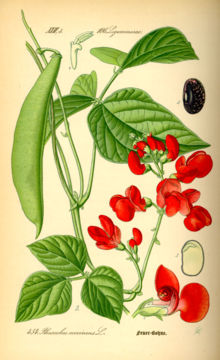Phaseolus coccineus
| Phaseolus coccineus | |
|---|---|
 |
|
| Scientific classification | |
| Kingdom: | Plantae |
| (unranked): | Angiosperms |
| (unranked): | Eudicots |
| (unranked): | Rosids |
| Order: | Fabales |
| Family: | Fabaceae |
| Subfamily: | Faboideae |
| Tribe: | Phaseoleae |
| Genus: | Phaseolus |
| Species: | P. coccineus |
| Binomial name | |
|
Phaseolus coccineus L. |
|
| Synonyms | |
|
List
|
|
Phaseolus coccineus, known as runner bean,scarlet runner bean, or multiflora bean, is a plant in the legume or Fabaceae family.
It is grown both as a food plant and an ornamental plant.
This species originated from the mountains of Central America. Most varieties have red flowers and multicolored seeds (though some have white flowers and white seeds), and they are often grown as ornamental plants. The vine can grow to 3 m (9 ft) or more in length.
It differs from the common bean (P. vulgaris) in several respects: the cotyledons stay in the ground during germination, and the plant is a perennial vine with tuberous roots (though it is usually treated as an annual).
The knife-shaped pods are normally green; however, there are very rare varieties bred by amateurs that have very unusual purple pods. An example of such a purple-podded runner bean is 'Aeron Purple Star'.
Runner beans have also been called "Oregon lima bean", and in Nahuatl ayocotl or in Spanish ayocote.
Runner beans, like all beans contain the toxic protein phytohaemagglutinin and thus should be cooked well before eating.
In the US, in 1978, the scarlet runner was widely grown for its attractive flowers primarily as an ornamental. Since that time, many US gardeners have adopted the bean as a regular member of the vegetable garden. The flower is known as a favourite of hummingbirds. In the UK - where the vegetable is a popular choice for kitchen gardens and allotments - the flowers are often ignored, or treated as an attractive bonus to cultivating the plant for the beans.
The seeds of the plant can be used fresh or as dried beans. The pods are edible whole while they are young and not yet fibrous. The starchy roots are still eaten by Central American Indians.
...
Wikipedia
